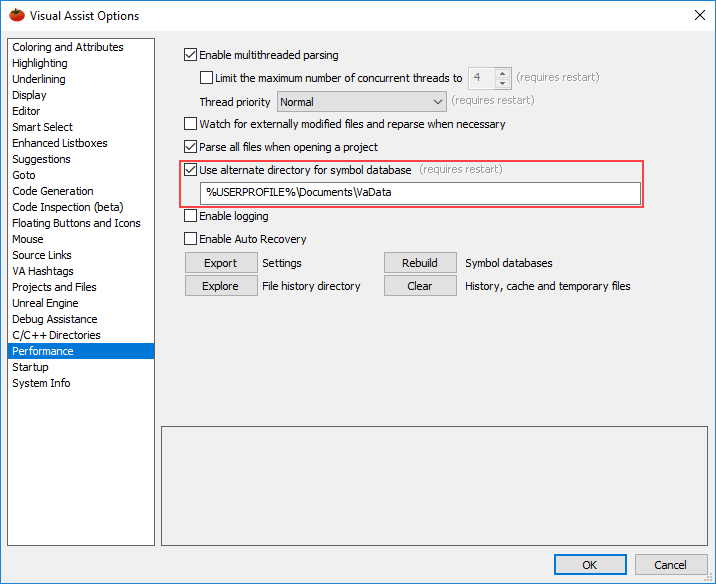By default Visual Assist, stores its symbol database, history, cache, and temporary files per user, in the following location:
Visual Studio 2012 and newer
C:\Users\%USERNAME%\AppData\Local\Microsoft\VisualStudio\<IDE version>\Extensions\<hashed name>\Data\
Visual Studio 2010
C:\Users\%USERNAME%\AppData\Local\Microsoft\VisualStudio\10.0\Extensions\Whole Tomato Software\Visual Assist X\
or
C:\Users\%USERNAME%\AppData\Local\Microsoft\VisualStudio\10.0\Extensions\<hashed name>\Data\
Visual Studio 2010; Windows XP
C:\Documents and Settings\%USERNAME%\Local Settings\Application Data\Microsoft\VisualStudio\10.0\Extensions\Whole Tomato Software\Visual Assist X\
Visual Studio 2008 and older
C:\Users\%USERNAME%\AppData\Local\VisualAssist\
Visual Studio 2008 and older; Windows XP
C:\Documents and Settings\%USERNAME%\Local Settings\Application Data\VisualAssist\
Alternate Location
In the Visual Assist Options dialog you can change the default symbol database directory by specifying a new one on the Performance settings. The alternate directory path can include environment variables.
You need to restart Visual Assist after setting a new directory.

You can also instruct Visual Assist to use an alternate location for its database by creating an expandable string value (REG_EXPAND_SZ) in the registry and setting it to:
HKCU\Software\Whole Tomato\UserDataDir = C:\<new_path>\
You may use environment variables in <new_path> as long as you use a REG_EXPAND_SZ. For example:
C:\%USERNAME%\<new_path>\
Environment variables are not supported if you use a string value (REG_SZ).
Requirements
You must have write permission to the alternate directory.
Do not copy any files from the original location to the new location. Delete the directory of the current database, set the alternate location in the registry, and let Visual Assist rebuild its database the next time you start your IDE.
Do not store the database in a location accessible to multiple environments. Each environment must have its own database. (To the contrary, per-user data may be shared.)
Do not share a directory or database with multiple users. Each user of a machine must have his own database(s).
Delete the UserDataDir key from the registry to revert to the default location.




 Documentation Home
Documentation Home Recently Changed
Recently Changed